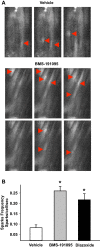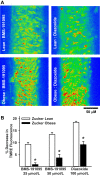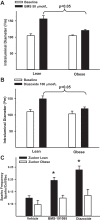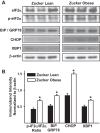Diversity of mitochondria-dependent dilator mechanisms in vascular smooth muscle of cerebral arteries from normal and insulin-resistant rats
- PMID: 24929852
- PMCID: PMC4137120
- DOI: 10.1152/ajpheart.00091.2014
Diversity of mitochondria-dependent dilator mechanisms in vascular smooth muscle of cerebral arteries from normal and insulin-resistant rats
Abstract
Mitochondrial depolarization following ATP-sensitive potassium (mitoKATP) channel activation has been shown to induce cerebral vasodilation by generation of mitochondrial reactive oxygen species (ROS), which sequentially promotes frequency of calcium sparks and activation of large conductance calcium-activated potassium channels (BKCa) in vascular smooth muscle (VSM). We previously demonstrated that cerebrovascular insulin resistance accompanies aging and obesity. It is unclear whether mitochondrial depolarization without the ROS generation enhances calcium sparks and vasodilation in phenotypically normal [Sprague Dawley (SD); Zucker lean (ZL)] and insulin-resistant [Zucker obese (ZO)] rats. We compared the mechanisms underlying the vasodilation to ROS-dependent (diazoxide) and ROS-independent [BMS-191095 (BMS)] mitoKATP channel activators in normal and ZO rats. Arterial diameter studies from SD, ZL, and ZO rats showed that BMS as well as diazoxide induced vasodilation in endothelium-denuded cerebral arteries. In normal rats, BMS-induced vasodilation was mediated by mitochondrial depolarization and calcium sparks generation in VSM and was reduced by inhibition of BKCa channels. However, unlike diazoxide-induced vasodilation, scavenging of ROS had no effect on BMS-induced vasodilation. Electron spin resonance spectroscopy confirmed that diazoxide but not BMS promoted vascular ROS generation. BMS- as well as diazoxide-induced vasodilation, mitochondrial depolarization, and calcium spark generation were diminished in cerebral arteries from ZO rats. Thus pharmacological depolarization of VSM mitochondria by BMS promotes ROS-independent vasodilation via generation of calcium sparks and activation of BKCa channels. Diminished generation of calcium sparks and reduced vasodilation in ZO arteries in response to BMS and diazoxide provide new insights into mechanisms of cerebrovascular dysfunction in insulin resistance.
Figures







Similar articles
-
Depolarization of mitochondria in neurons promotes activation of nitric oxide synthase and generation of nitric oxide.Am J Physiol Heart Circ Physiol. 2016 May 1;310(9):H1097-106. doi: 10.1152/ajpheart.00759.2015. Epub 2016 Mar 4. Am J Physiol Heart Circ Physiol. 2016. PMID: 26945078 Free PMC article.
-
Impaired mitochondria-dependent vasodilation in cerebral arteries of Zucker obese rats with insulin resistance.Am J Physiol Regul Integr Comp Physiol. 2009 Feb;296(2):R289-98. doi: 10.1152/ajpregu.90656.2008. Epub 2008 Nov 12. Am J Physiol Regul Integr Comp Physiol. 2009. PMID: 19005015 Free PMC article.
-
Depolarization of mitochondria in endothelial cells promotes cerebral artery vasodilation by activation of nitric oxide synthase.Arterioscler Thromb Vasc Biol. 2013 Apr;33(4):752-9. doi: 10.1161/ATVBAHA.112.300560. Epub 2013 Jan 17. Arterioscler Thromb Vasc Biol. 2013. PMID: 23329133 Free PMC article.
-
Role of Mitochondria in Cerebral Vascular Function: Energy Production, Cellular Protection, and Regulation of Vascular Tone.Compr Physiol. 2016 Jun 13;6(3):1529-48. doi: 10.1002/cphy.c150051. Compr Physiol. 2016. PMID: 27347901 Review.
-
Mitochondrial mechanisms in cerebral vascular control: shared signaling pathways with preconditioning.J Vasc Res. 2014;51(3):175-89. doi: 10.1159/000360765. Epub 2014 May 22. J Vasc Res. 2014. PMID: 24862206 Free PMC article. Review.
Cited by
-
Functional vascular contributions to cognitive impairment and dementia: mechanisms and consequences of cerebral autoregulatory dysfunction, endothelial impairment, and neurovascular uncoupling in aging.Am J Physiol Heart Circ Physiol. 2017 Jan 1;312(1):H1-H20. doi: 10.1152/ajpheart.00581.2016. Epub 2016 Oct 28. Am J Physiol Heart Circ Physiol. 2017. PMID: 27793855 Free PMC article. Review.
-
Urinary angiotensinogen increases in the absence of overt renal injury in high fat diet-induced type 2 diabetic mice.J Diabetes Complications. 2020 Feb;34(2):107448. doi: 10.1016/j.jdiacomp.2019.107448. Epub 2019 Oct 5. J Diabetes Complications. 2020. PMID: 31761419 Free PMC article.
-
High-plasma soluble prorenin receptor is associated with vascular damage in male, but not female, mice fed a high-fat diet.Am J Physiol Heart Circ Physiol. 2023 Jun 1;324(6):H762-H775. doi: 10.1152/ajpheart.00638.2022. Epub 2023 Mar 17. Am J Physiol Heart Circ Physiol. 2023. PMID: 36930656 Free PMC article.
-
Depolarization of mitochondria in neurons promotes activation of nitric oxide synthase and generation of nitric oxide.Am J Physiol Heart Circ Physiol. 2016 May 1;310(9):H1097-106. doi: 10.1152/ajpheart.00759.2015. Epub 2016 Mar 4. Am J Physiol Heart Circ Physiol. 2016. PMID: 26945078 Free PMC article.
-
G Protein-Coupled Estrogen Receptor Protects From Angiotensin II-Induced Increases in Pulse Pressure and Oxidative Stress.Front Endocrinol (Lausanne). 2019 Aug 27;10:586. doi: 10.3389/fendo.2019.00586. eCollection 2019. Front Endocrinol (Lausanne). 2019. PMID: 31507536 Free PMC article.
References
-
- Ahmad N, Wang Y, Haider KH, Wang B, Pasha Z, Uzun O, Ashraf M. Cardiac protection by mitoKATP channels is dependent on Akt translocation from cytosol to mitochondria during late preconditioning. Am J Physiol Heart Circ Physiol 290: H2402–H2408, 2006 - PubMed
-
- Bray GA. The Zucker-fatty rat: a review. Fed Proc 36: 148–153, 1977 - PubMed
Publication types
MeSH terms
Substances
Grants and funding
LinkOut - more resources
Full Text Sources
Other Literature Sources

